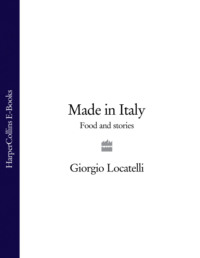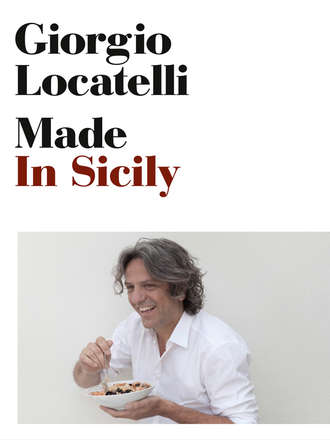
Полная версия
Made in Sicily
Spread each square of rolled-out dough with 1 tablespoon of melted strutto, or olive oil. Scatter the sausage meat and pancetta over the top, followed by the onions and cheese, season well with black pepper, then roll up and place on the baking tray/trays. Bake in the preheated oven for 15–30 minutes, or until golden. Cut each roll into thick slices and serve.
Torta di sambuco
Meat pie with elderflower
This is another unusual ‘pie’ which is made in the spring, when the elderflowers are blossoming, and which is cut up and served with the antipasti. Guanciale is a bacon made from pork jowl, cured in wine, herbs and black pepper. If you can’t find it, use some good lardons or cubed pancetta.
Serves 6
For the dough:
30g fresh yeast
500g semolina flour, plus more as needed
500g ‘00’ flour
1 teaspoon sugar
20g sea salt
80ml olive oil
1 egg, beaten, for brushing
For the filling:
4 tablespoons olive oil
300g guanciale, chopped
400g rustic salame, roughly chopped
300g tuma (Sicilian unsalted sheep’s milk cheese) or pecorino, chopped
50g elderflowers, chopped
Mix the yeast with 400ml of water. In a food mixer with a dough hook, mix the flours and sugar, add the yeast and water, and mix. Add the salt and when it is incorporated, add 2 tablespoons of the olive oil. Mix until soft and elastic, then emulsify the rest of the olive oil with another 50ml of water and add it to the dough a little at a time, with the motor turning, until the dough is soft. Turn out into a bowl and leave to rise in a warm place for at least 2 hours.
Preheat the oven to 180°C/350°F/gas 4.
To make the filling, heat 2 tablespoons of olive oil in a pan, put in the guanciale and cook until golden brown all over, then lift out and drain on kitchen paper. Mix, in a bowl, with the salame, cheese and elderflowers.
Rub the dough with another tablespoon of olive oil. Cut in half, and roll one half into a sheet large enough to line a tart tin. Scatter with the guanciale mixture and drizzle with the remaining tablespoon of olive oil. Cover with the other half of the dough, pressing around the edges to seal. Brush the top with the beaten egg and bake in the oven for 40 minutes, until golden. Slice and serve hot.
Schiacciata con salsiccia
Schiacciata with sausage
This is typical of the area around Agrigento, another very rich pie that is cut up and served as an antipasti … very moreish, but also very filling.
Serves 6
4 whole black olives in brine
sea salt and freshly ground black pepper
1 head of cauliflower, cut into small pieces
2 tablespoons olive oil, plus a little extra for greasing and finishing
200g 100 per cent pork sausages
1 large potato, peeled and cut into large chunks
1 medium onion, sliced
60g caciocavallo or pecorino cheese, diced
For the dough:
500g semolina flour, plus more as needed
500g ‘00’ flour
30g fresh yeast
80ml olive oil
20g sea salt
5g sugar
1 egg, beaten, for brushing
First make the dough. In a food mixer with a dough hook, mix the flours, yeast, 2 tablespoons of the olive oil, 400ml of water, the salt and the sugar. Mix until soft and elastic, then emulsify the rest of the olive oil with another 50ml of water and add it to the mixer bowl a little at a time, with the motor turning, until the dough is soft. Turn out into a bowl and leave to rise in a warm place for at least 2 hours.
Drain the olives and pat dry. With a sharp knife, make three or four cuts in each olive from end to end, then cut each segment away from the stone as carefully as you can.
Bring a large pan of salted water to the boil. Put in the cauliflower and blanch for a minute then drain.
Preheat the oven to 180°C/350°F/gas 4 and brush a baking dish with olive oil. Remove the skins from the sausages and break the sausage meat into pieces.
Heat the olive oil in a pan and brown the sausage meat. Lift out and drain on kitchen paper. Add the potatoes to the pan in which you cooked the sausages, season, and sauté until golden and just tender. Lift out and drain on kitchen paper, then put the onion into the same pan and cook gently until soft but not coloured. Add the cauliflower and season with salt to taste.
Put the sausage and potatoes back into the pan of onion and cauliflower, along with the olives, and season well with black pepper. Stir everything together for a minute or so, then take off the heat.
Dust your work surface with flour, and roll out the dough to about 6mm thick. Divide it into two: you need one piece big enough to line a shallow baking dish, and the other to put over the top. Line the dish with the bigger sheet of dough, then spoon in the sausage mixture. Scatter the cheese over, then cover with the other sheet of dough and seal the edges all round. Brush with a little more olive oil.
Put into the preheated oven and bake for 20–30 minutes, or until the top is golden.
Prezzemolo e aglio, oli e condimenti
Parsley and garlic, oils and dressings
Prezzemolo e aglio
Parsley and garlic
This is just a way of preparing parsley and garlic that brings out the maximum flavour in both, and is something I’ve always done. Every morning in the restaurant we prepare it. To 1 garlic clove we use about 4 handfuls of flat-leaf parsley. We put the garlic cloves on a chopping board and crush them with the flat of a kitchen knife, so that they become a paste. Then we put the parsley on top and chop it finely, so that we are chopping through the garlic at the same time, and the two flavours mingle.
Olio all’aglio
Garlic oil
It is a very Sicilian thing to make fresh garlic oil; I don’t remember going into anyone’s house and seeing a bottle that had been bought from a shop. Make it in small batches and use it up quickly.
Makes about 50ml
2 garlic cloves, finely chopped
50ml olive oil
Mix together and leave for a day in the fridge before using. It will keep, refrigerated, for up to 3 days.
When you spoon it out, you should have about 75 per cent oil and 25 per cent chopped garlic.
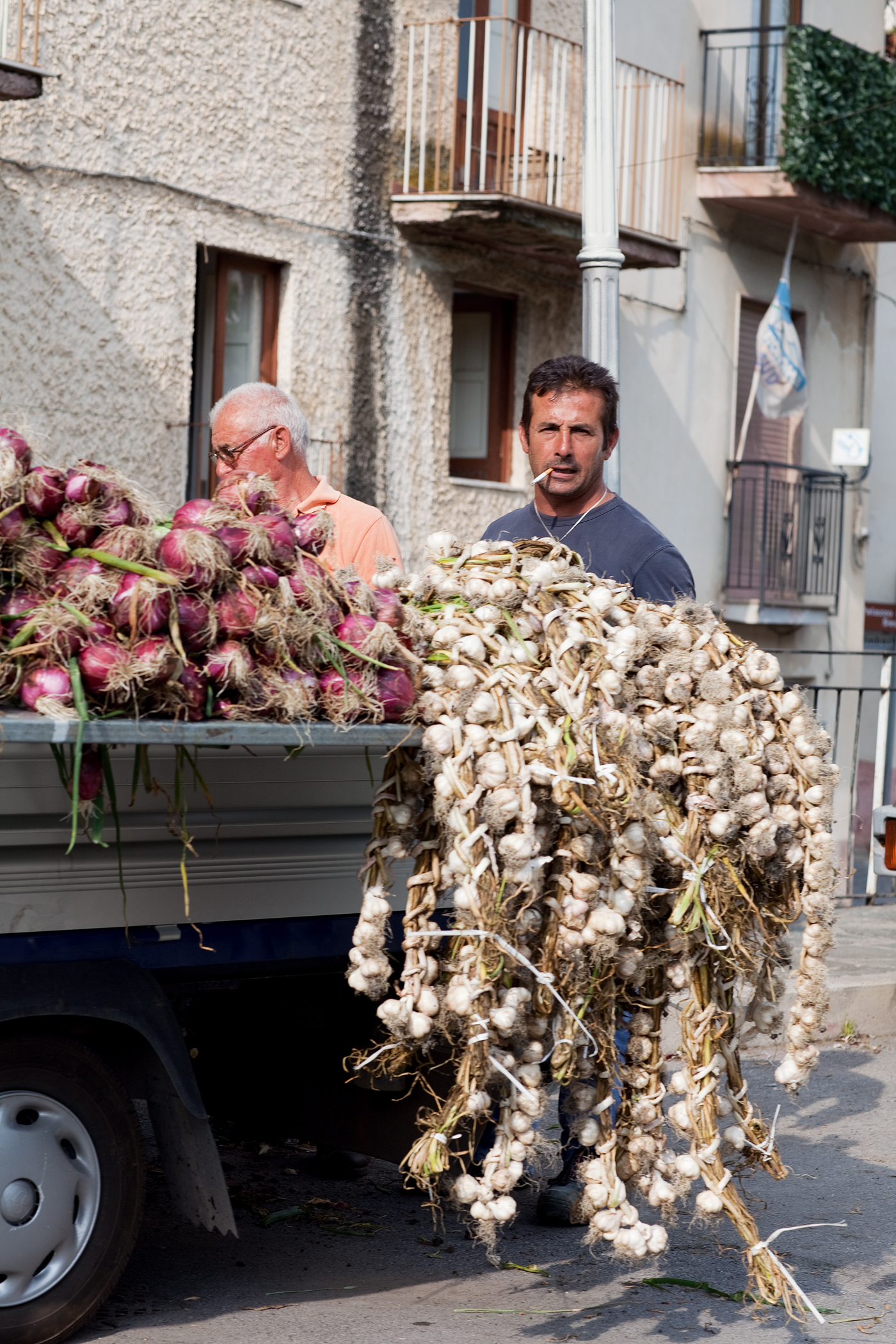
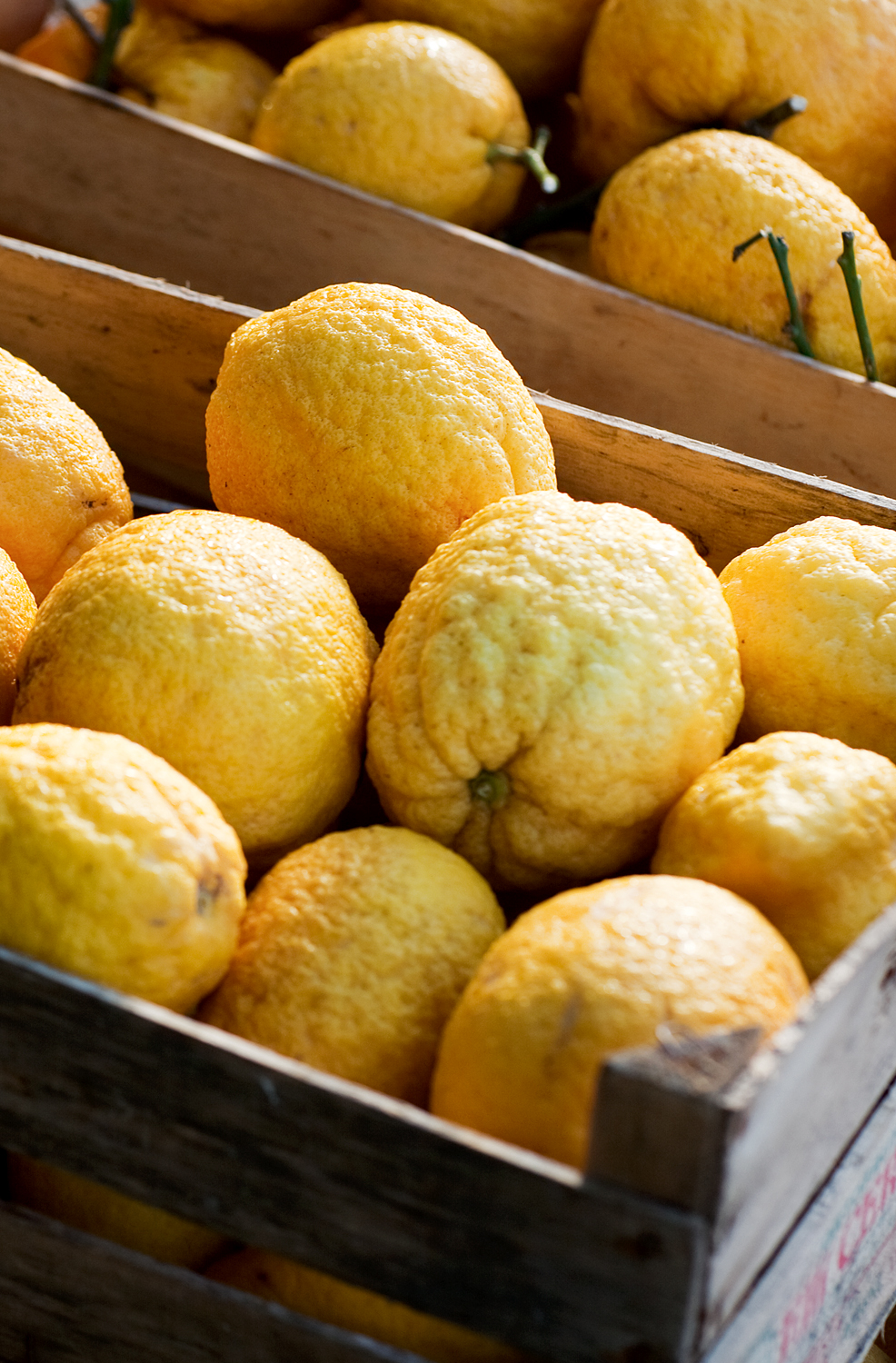
Olio di limone
Lemon oil
This is the simplest combination of oil and lemon juice, but when it is made with the juice of Sicilian lemons the flavour is brilliant. It should be used immediately after making, otherwise the flavour of the lemon will change, so adjust the quantities according to how much you need.
Makes about 200ml
a pinch of salt
3 tablespoons fresh lemon juice
150ml extra virgin olive oil
Put the salt into a clean, screw-topped bottle or jar, then add the lemon juice and leave for a minute until the salt dissolves. Add the oil and shake really well to emulsify. Use straight away.
Olio di peperoncino
Chilli oil
Like all the countries that face the Mediterranean, Sicily favours the chilli pepper, much more than the rest of Italy, especially the north. As well as fresh chillies, you will find little strings of dried ones that are often just crumbled into dishes.
I like the kick of spice that chilli brings to a broccoli and almond salad (Insalata di broccoli, mandorle e peperoncino) or some green vegetables, simply blanched and tossed in olive oil with chilli and garlic. How hot Sicilian chillies are is a bit of a lottery; they can be quite gentle and sweet, or they can be explosive.
Makes about 50ml
½ fresh red chilli, finely chopped
½ fresh green chilli, finely chopped
50ml olive oil
Mix together and leave for a day in the fridge before using. It will keep, refrigerated, for up to 3 days. When you spoon it out, you should have about 75 per cent oil and 25 per cent chopped chilli.
Giorgio’s dressing
As I explained in my previous book, Made in Italy, there is nothing mysterious or special about this, it is just the label we used to put on the bottle of vinaigrette in the kitchen when I was cooking at Zafferano, to help out a young chef who otherwise could never remember which dressing was which. I like a high ratio of oil to vinegar, but you can vary it as you like. Naturally, since we started making our own oil in Sicily, that is the one we use, and now we also add some white wine vingar. You will find that Sicilian oils are generally very fresh, grassy, fruity and fragrant. Make up a bottle of this and keep it in the fridge.
Makes about 375ml
½ teaspoon sea salt
3 tablespoons red wine vinegar
2 tablespoons white wine vinegar
300ml extra virgin olive oil, preferably Sicilian
Put the salt into a bowl, then add the vinegars and leave for a minute until the salt dissolves. Whisk in the olive oil and 2 tablespoons of water until the vinaigrette emulsifies. Pour into a clean bottle and store in the fridge for up to 6 months. It will separate out again, but just shake it well before you use it.
Salsetta, salmoriglio e pesto Light sauces and pesto
Sicilians are not keen on heavy cooked sauces; however, light, fresh salsette and salmoriglio – a dressing made with oil and lemon or vinegar, plus garlic and herbs – along with pesto are at the base of their cooking and eating. I like the idea of putting a few of these out in bowls with the antipasti, so that they can be spooned on to vegetables or fish or seafood.
If you say pesto to most people, they think of pesto genovese (named after Genoa), made with Parmesan, pine nuts and basil; but if you say pesto to a Sicilian, they think of pesto trapanese (named after Trapani), made with almonds and tomatoes (Pesto trapanese). The word ‘pesto’ comes from the verb pestare, which just means to crush or grind, and it simply refers to a sauce that is traditionally pounded with a pestle and mortar, so the combination of ingredients can be very localised.
As well as working well with vegetables, meat or fish, the pesto-style sauces are obviously perfect tossed through pasta. Of course, you can make pesto by putting all the ingredients into a blender and pressing the pulse button, rather than working it in a pestle and mortar, but doing it by machine will give you a smoother, more refined texture than the more rustic sauce that is the result of using a pestle and mortar.
Salsa salmoriglio
Oil, lemon and herb sauce
Salmoriglio is almost always on the Sicilian table, ready to spoon over vegetables, grilled fish or meat, and there are many different variations: sometimes chopped, sun-dried tomato might be added, sometimes lemon zest along with the lemon juice, or different herbs. You could vary the one below by using 40ml of white wine vinegar in place of the lemon juice, or substituting marjoram for the oregano. Marjoram is a herb that is used a lot in Sicily – our friends at Planeta grow it in huge pots on their terrace. It is the same family as oregano, but a little lighter and slightly more bitter.
Makes about 150ml
120ml olive oil
juice of 2 lemons
30g flat-leaf parsley, chopped
1 garlic clove, finely chopped
10g dried oregano
sea salt and freshly ground black pepper
Whisk together the olive oil, lemon juice and a dessertspoonful of warm water. Gradually whisk in the parsley, garlic, oregano, salt and pepper until thickened slightly.
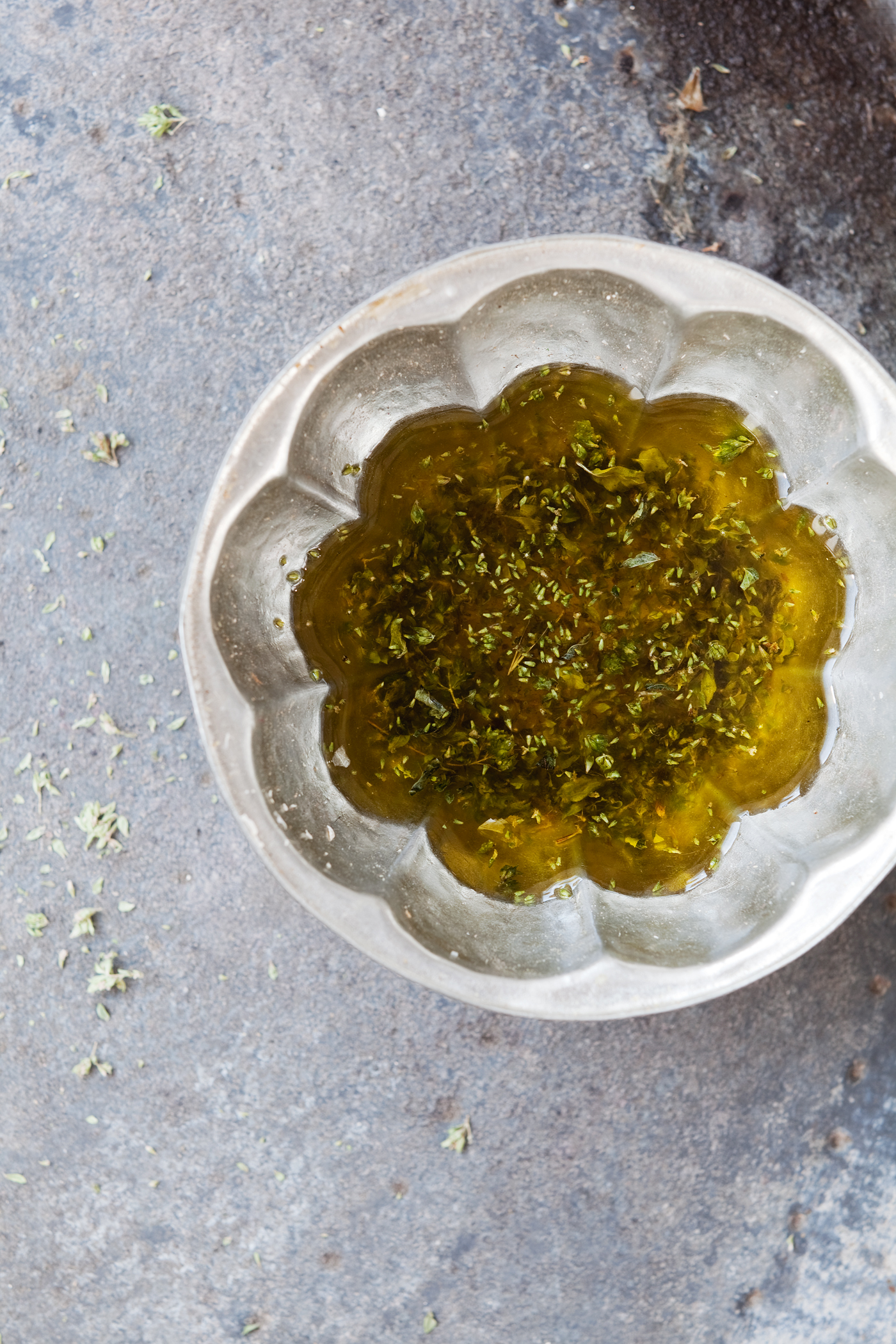
Zogghiu
Garlic, mint and lemon sauce
This is another light sauce used for grilled fish, or traditionally for dipping boiled snails into, or spooning over grilled meat.
Makes about 150ml
2 garlic cloves, chopped
sea salt
50g mint, chopped
3 tablespoons fresh lemon juice
6 tablespoons olive oil
Using a pestle and mortar, crush the garlic into a paste with 2 pinches of salt, add the mint and continue to crush, then finally work in the lemon juice and the olive oil, a little at a time.
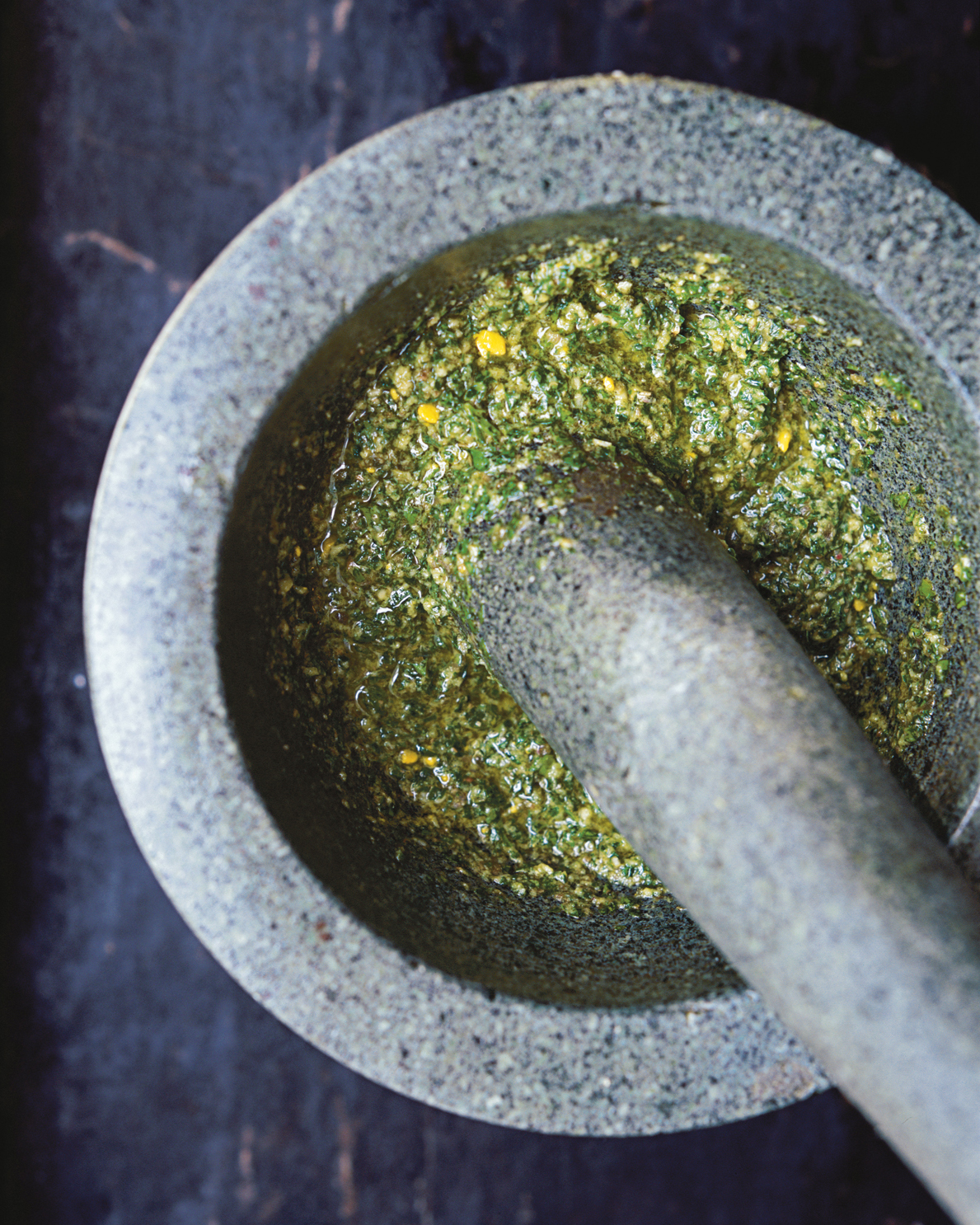
Salsa verde
Green sauce
Again, this is a great sauce for grilled fish.
Makes 300g
1 salted anchovy
3 whole green olives in brine
1 garlic clove
100g flat-leaf parsley, chopped
30g pine nuts
15g salted capers, rinsed and well drained
1 slice of good white bread, soaked in vinegar
yolk of 1 large hard-boiled egg
120ml extra virgin olive oil, plus more as needed
15ml white wine vinegar, or to taste
sea salt and freshly ground black pepper
Rinse and dry the anchovy. Run your thumb gently along the backbone to release it, and you should be able to easily pull it out.
Drain the olives and pat dry. With a sharp knife, make three or four cuts in each olive from end to end, and then cut each segment away from the stone as carefully as you can.
Grind the garlic, anchovy and parsley using a pestle and mortar until you have a green paste, then add the pine nuts, capers and olives and pound for a few more minutes. Add the bread and pound again. Work in the hard-boiled egg yolk, and finally add the oil, a little at a time, working it in well as you go. Taste and add vinegar, and/or salt and pepper as you wish. If you like a thinner, creamier sauce, add a little more extra virgin olive oil.
Mandorle Almonds
‘A symbol of good fortune’
Almonds are so important throughout Italy, in cakes, amaretti biscuits and amaretto liqueur, and are a symbol of good fortune: sugar-coated almonds, known as confetti, are traditional at Italian weddings and baptisms. In Sicily they are also used in savoury dishes, in pestos (Pesto trapanese), and in salads (broccoli, almond and chilli salad), but what is sad is that whereas the pistachios of Bronte (Il pistacchio verde di Bronte) have been recognised as special, and command high prices, almonds have been left behind.
Many people in the countryside have an almond tree in their garden. However, where once you would see almonds being grown commercially all over the island, the nuts have had to fight in the market place with cheaper ones produced around the world, and have ended up being priced out. So many people have pulled up their almond groves, and planted grapes and olives instead, and while almonds are used as much in Sicilian cooking as ever, especially in the beloved almond paste, or marzipan, the nuts are often not home grown, but cheaper imports.
However, there is hope for the most famous almond groves, in the Siracusa area, between Noto and Avola, where Slow Food are now championing three old varieties of almond: the squat-shaped, perfumed and quite intense Romana, the longer, more elegant, pointed Pizzuta d’Avola, and the Fascionello, which is a good all-round almond.
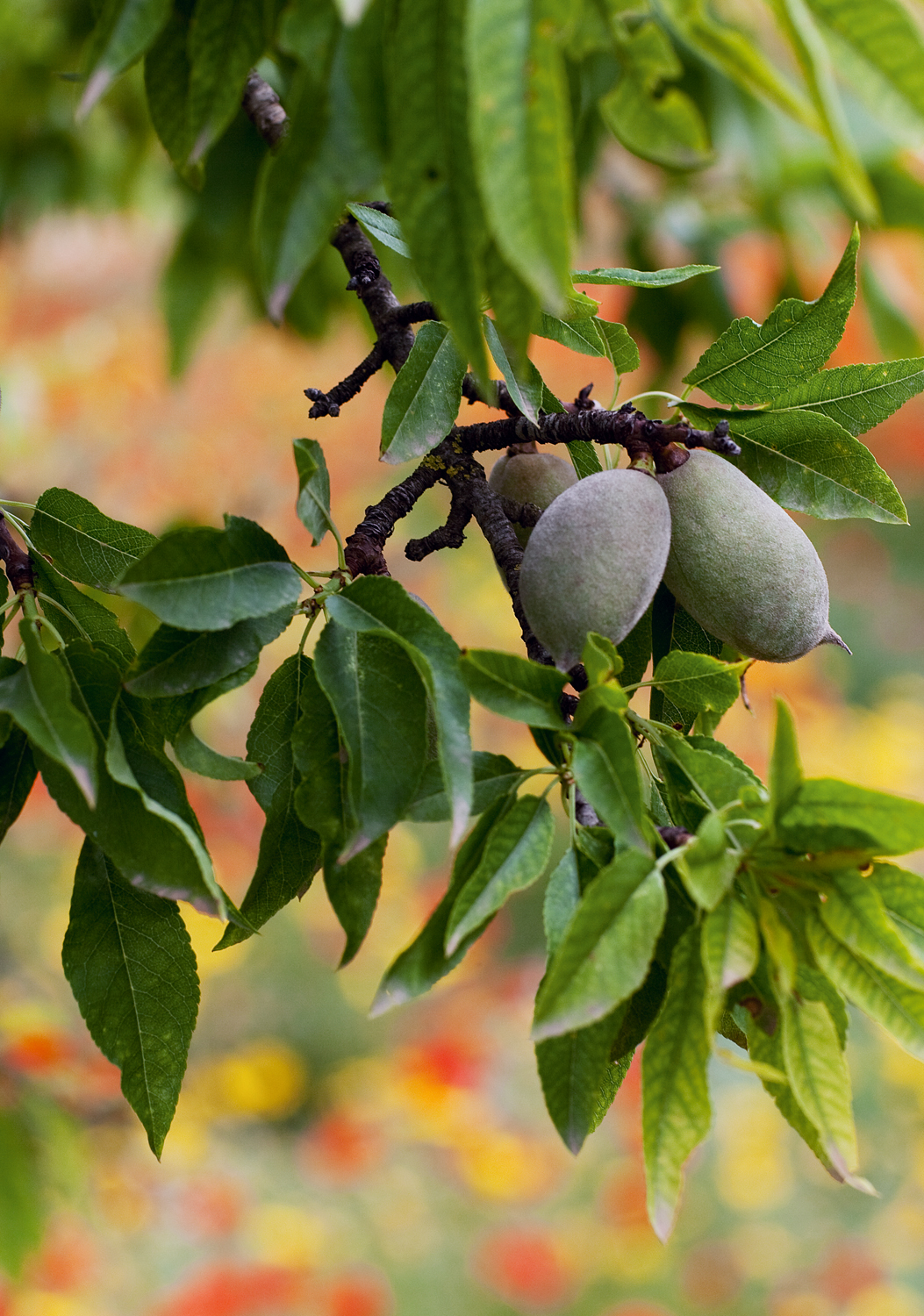
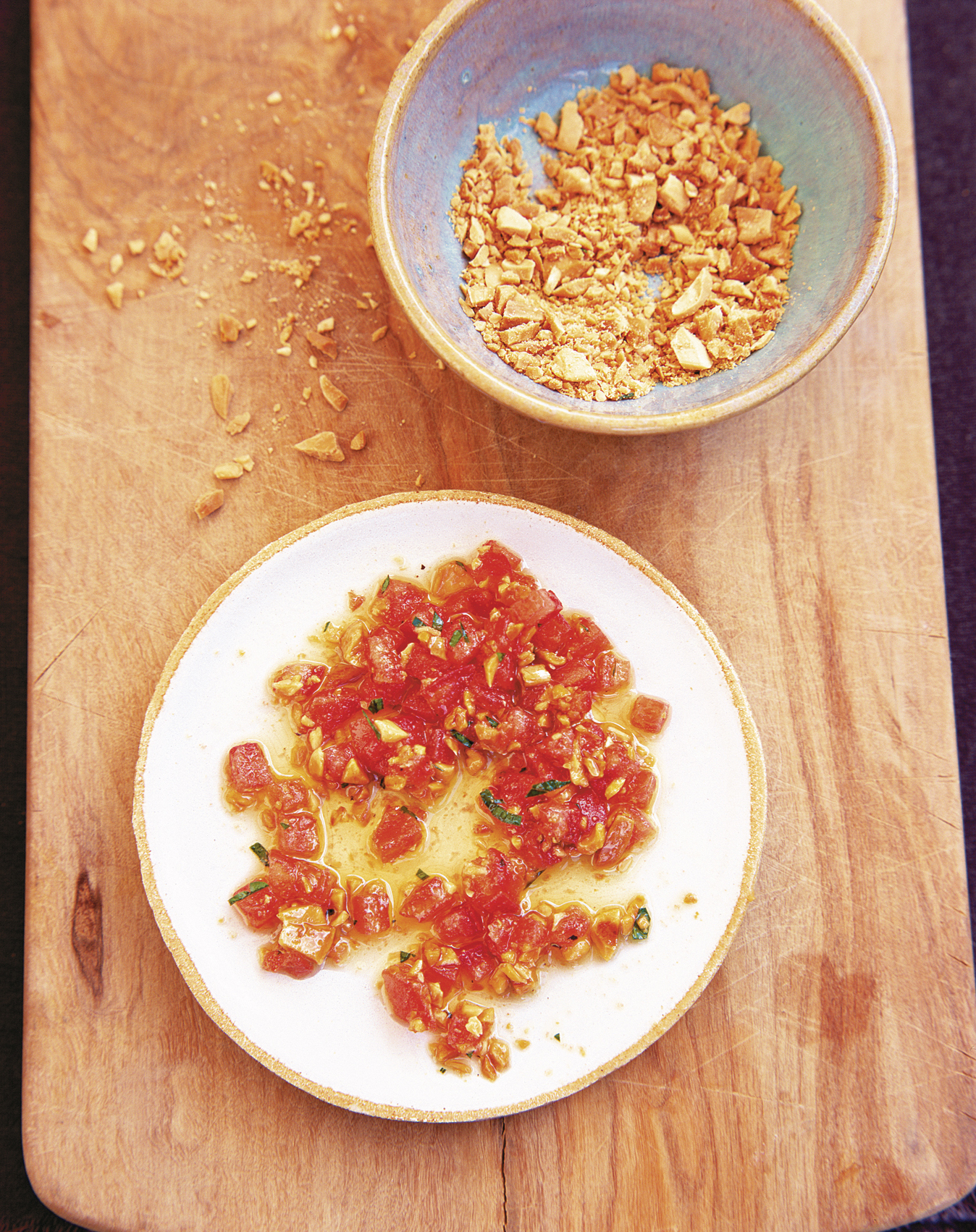
Pesto trapanese
Tomato and almond pesto
Use this with fish or meat, or toss through pasta.
Makes about 600g
75g almonds
500g plum tomatoes
4 garlic cloves
sea salt and freshly ground black pepper
40g fresh mint, shredded
50ml olive oil
Heat the oven to 180°C/350°F/gas 4. Lay the almonds in a single layer on a baking tray and put into the oven for about 8 minutes. As long as they are in a single layer you don’t need to turn them. Keep an eye on them to make sure they don’t burn, and when they are golden, take them out and chop them.
Put the tomatoes into a pan of boiling water for 10 seconds, then drain them under cold water and you should be able to peel them easily. Cut them in half, scoop out the seeds with a teaspoon, and chop the flesh.
Grind the toasted almonds with the garlic, using a pestle and mortar, until you have a paste. Add the tomatoes, salt, pepper and mint and pound again very briefly, just to crush the tomatoes a little. Then add the olive oil a little at a time, working it into the paste.
Salsetta di mandorle e acciughe
Almond and anchovy sauce
The touch of cinnamon in this is a reminder of the Arab influence in Sicily. Use this like a pesto, with vegetables, fish or pasta.
Makes about 350g
6 salted anchovies
90g almonds
60g breadcrumbs
10 mint leaves, chopped
a pinch of ground cinnamon
1 tablespoon white wine vinegar
1 tablespoon fresh lemon juice
140ml olive oil, or as needed
Preheat the oven to 180°C/350°F/gas 4.
Rinse and dry the anchovies. Run your thumb gently along the backbone to release it, then you should be able to easily pull it out.
Spread the almonds over a baking tray and the breadcrumbs over a separate tray. Put both in the oven to toast for about 8 minutes until golden, keeping an eye on them to make sure they don’t burn, then remove and chop the almonds.
Using a pestle and mortar, pound the toasted almonds, then add the breadcrumbs and anchovies and pound some more. Add the mint leaves, cinnamon, vinegar, lemon juice, and enough olive oil to pound to a creamy sauce.
Salsa di pomodoro
Tomato sauce
I was staying in a small, very simple hotel in Piazza Armerina in the province of Enna, and in the morning the woman asked, ‘How was the food last night?’ I said that it was fantastic, very natural in its flavours, especially the tomato sauce, and she was so happy. She told me, ‘I can cook tomato sauce like no one else. My cousin even steals my tomatoes, but she can’t make the sauce as good.’ Everybody in Sicily is so proud of their sauce, which gets passed from grandmother to mother to daughter. Usually people are also sworn to one kind of tomato, whose acidity and sweetness they understand.
In Vittorio’s kitchen, every morning, one of the women comes in, peels a whole case of tomatoes, and starts the sauce. Then at 9.30am Vittorio’s son-in-law, Ignazio, arrives and the sauce is bubbling away, so he tastes it, adds a bit of salt and puts the lid on the pan. At 10-10.30am Vittorio arrives, tastes it and puts in a bit of salt and sugar. At 11am Vittorio’s son, Michelangelo, arrives, and says the sauce needs something else. It is like a son with a thousand fathers, that sauce.
The sauce below is the one we make at Locanda with very ripe tomatoes, but tinned tomatoes are fine when you can’t find good fresh ones. Remember, when you use fresh tomatoes, don’t be scared that the sauce is going to be too dry. Tomatoes are about 70 per cent water, and only 30 per cent fibre, so you have to let them cook slowly and the liquid will come out. Don’t panic and add half a litre of water, because then you will have soup.
The olives give a little bitterness and edge, and you can add a pinch of dry oregano if you like as the sauce cooks. In Modica, around Easter time, I had some quite sweet tomato sauces balanced with wild fennel, that went with ravioli di ricotta – this was one of the few times I ever ate filled pasta on the island, as dried pasta is much more typical. That Sambuca-like flavour is something I never thought would work with tomato, but it goes perfectly.
10 whole black olives in brine
2 tablespoons olive oil
1 medium white onion, finely chopped
1.5kg ripe, fresh tomatoes or 1kg tinned chopped tomatoes
sea salt and freshly ground black pepper
a little sugar if needed
Drain the olives and pat dry. With a sharp knife, make three or four cuts in each olive from end to end, and then cut each segment away from the stone as carefully as you can.
Heat the olive oil in a pan, add the onion and cook until soft but not coloured. Add the olives and cook for 2 minutes, then add the tomatoes and simmer for 30 minutes. Season to taste, adding a little sugar if the tomato is too acidic, and pass through a fine sieve.
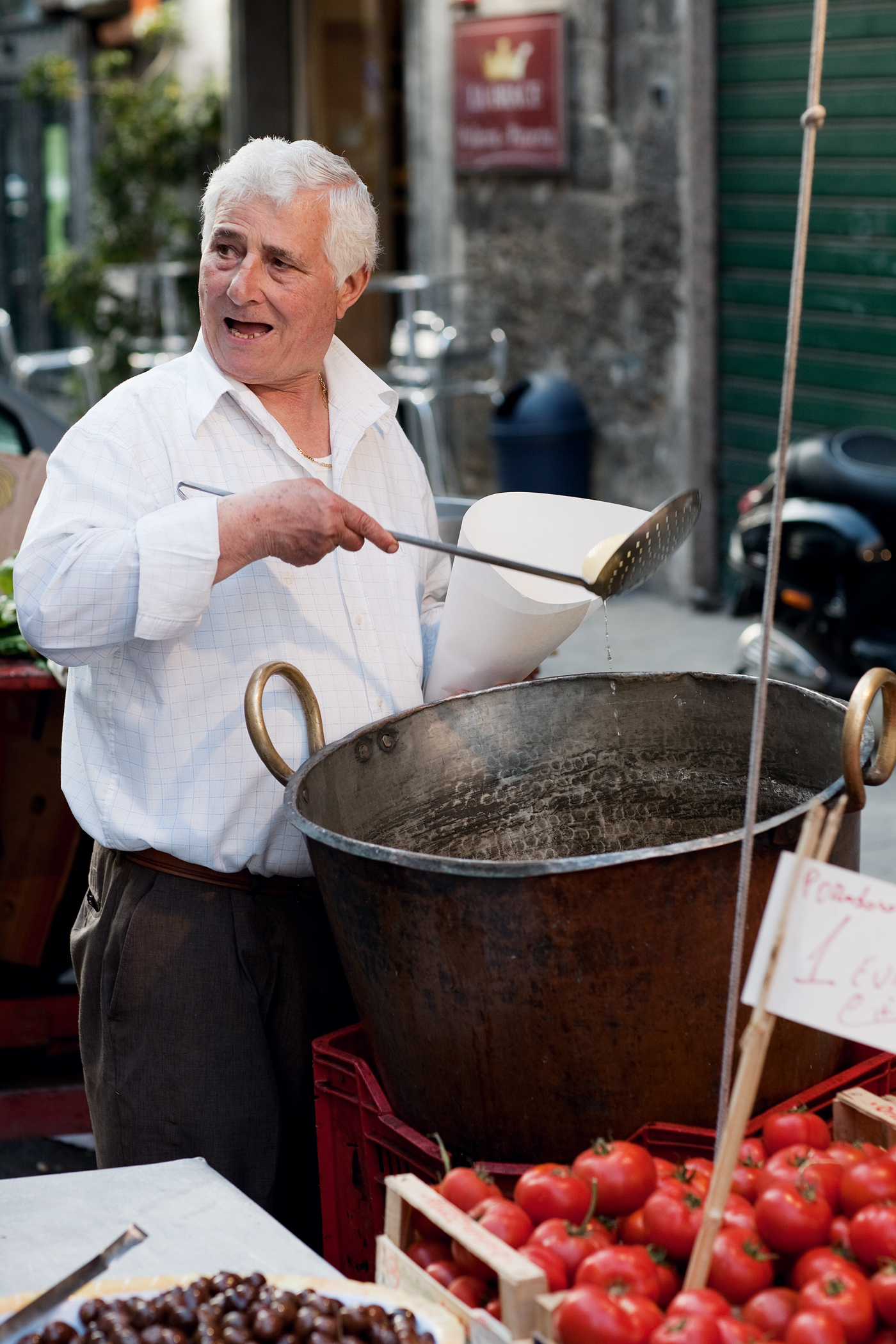
‘A city that leaves you breathless’
At the heart of Sicily’s history is its food, and at the heart of its food is its history, but what comes through it all is a character that is only Sicilian. Giuseppe Tomasi di Lampedusa wrote, ‘Sicily is Sicily – 1860, earlier, forever’ (1860 was the year of the unification of Italy), and that is what I feel. Sicily is Sicily, and like nowhere else, even though it is an island of great contrasts: in the way it looks, from the humble to the baroque, and in its food, so full of different, bold and vibrant flavours that you expect to be discordant, but somehow they come together and bowl you over.
In Palermo I love the street food: the guys outside the restaurants grilling fish for people to take home, the vendors selling sea urchin with lemons, panelle – fantastic little fritters of chickpea flour (Panelle di ceci) – and all kinds of tripe, such as quaruma (veal or beef entrails) or mascellato (pieces of jaw); stigghiola, intestines of sheep or goat, soaked in wine, then wound around sprigs of parsley and barbecued; or pane con la milza – sandwiches filled with beef spleen, which is boiled, and kept warm in a big pot like a wok. The pieces of spleen are put inside soft white focaccia-like buns, known as guasteddi, with a sprinkling of salt and a squeeze of lemon, and the flavour is delicious. Sometimes fresh ricotta and grated caciocavallo cheese are added, and the sandwich is called maritatu – it is said that this is what Garibaldi ate when he landed in Palermo in 1860.
Palermo doesn’t feel like a European city. It leaves you breathless from the noise and the beauty of the Arabic sense of colour and abundance in the markets, the bakeries and crazy cake shops, the gelaterie, bars and cafés full of every shade and flavour of ice cream and granite.
It is so different to the south-west coast, only an hour and a half’s drive away, where you see more of the ancient, classical influence. If you go out with the fishermen and look back to the Valley of the Temples, further around the coast, between Sciacca and Mazara del Vallo, you can see where once there was a Greek city on the flat plain above the swamps, where people were scared of malaria.
In the villages the shops are sometimes so small, they are little more than holes in the wall; there is no heavy industry, and everyone is dedicated to fishing, or the production of grapes and olives. Old men sit around on their chairs in the village square, as if the street is just an extension of their houses, just sitting and talking and watching. The first time we went on holiday, Jack was saying: ‘Why are they sitting on the street? Don’t they have houses?’ Sometimes, if the men have an affiliation to a political party, they will put their chairs outside their office, or maybe outside the confraternity of olive pickers. And when they are talking, I am sure it’s about food, because everyone talks – or argues – about food: who makes the authentic version of a pasta, whose mother had the best recipe.
Dramatically different again is the eastern side of the island, where Noto was rebuilt after Mount Etna erupted, and Modica was rebuilt after the earthquake of 1693. Everything is very elaborate, very baroque. Then, as you travel upwards through the plain of Catania, towards Mount Etna, you meet people who speak in a different dialect to the people who face the sea, and they seem to talk in proverbs. If anything, they appear to be even more resilient, even more Sicilian, because they live in the shadow of the mountain the ancient people called the monster with a hundred heads. It is not just one volcano, but a series of them, and every so often it shoots up its ‘bombs’ of molten lava, and when people find them, they write their names on them.




